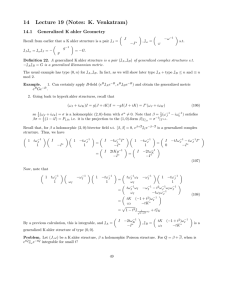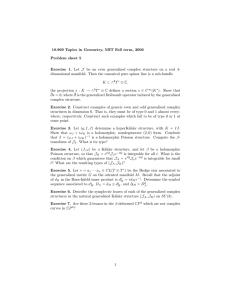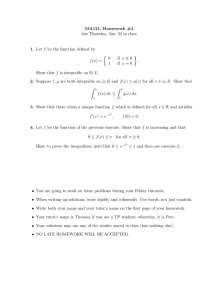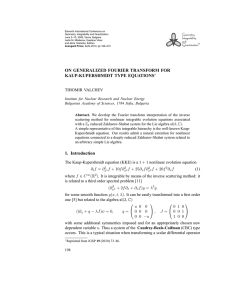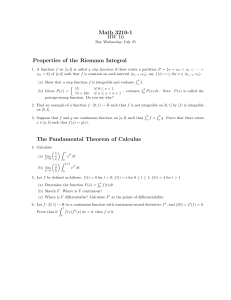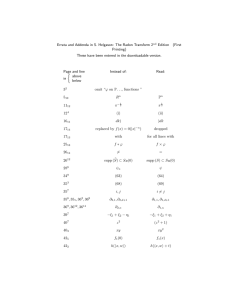13 Lecture 18 (Notes: K. ... 13.1 Generalized K ahler Geometry
advertisement
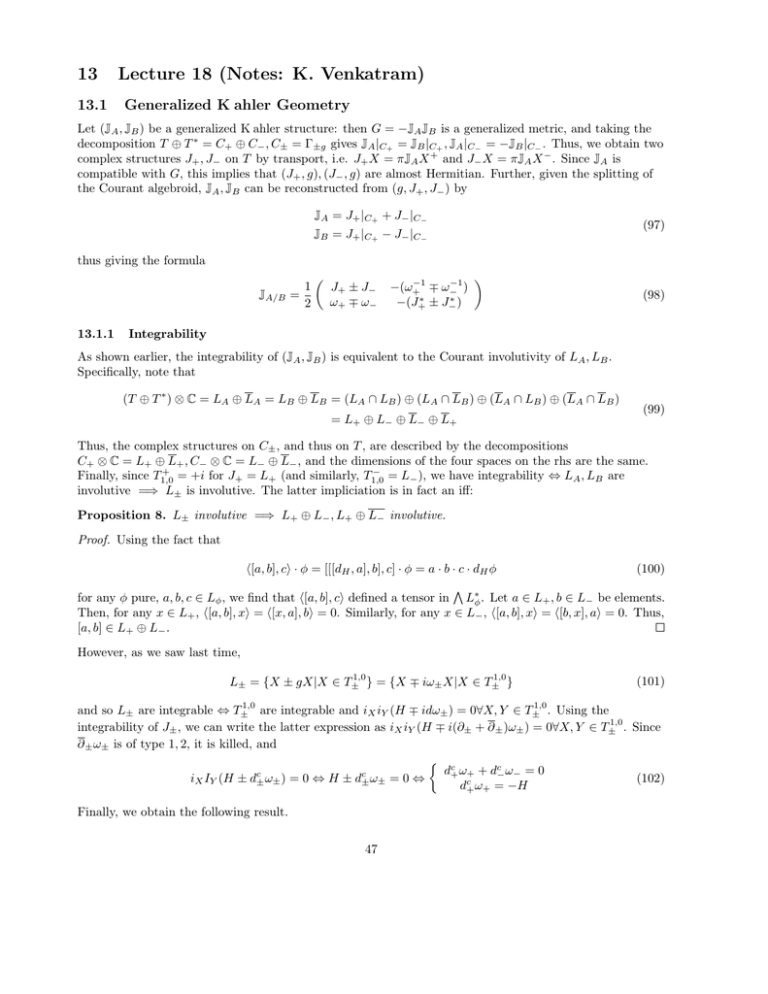
13
13.1
Lecture 18 (Notes: K. Venkatram)
Generalized K ahler Geometry
Let (JA , JB ) be a generalized K ahler structure: then G = −JA JB is a generalized metric, and taking the
decomposition T ⊕ T ∗ = C+ ⊕ C− , C± = Γ±g gives JA |C+ = JB |C+ , JA |C− = −JB |C− . Thus, we obtain two
complex structures J+ , J− on T by transport, i.e. J+ X = πJA X + and J− X = πJA X − . Since JA is
compatible with G, this implies that (J+ , g), (J− , g) are almost Hermitian. Further, given the splitting of
the Courant algebroid, JA , JB can be reconstructed from (g, J+ , J− ) by
JA = J+ |C+ + J− |C−
JB = J+ |C+ − J− |C−
(97)
thus giving the formula
JA/B =
13.1.1
1
2
�
J+ ± J−
ω+ � ω−
−1
−1
−(ω+
� ω−
)
∗
∗
−(J+
± J−
)
�
(98)
Integrability
As shown earlier, the integrability of (JA , JB ) is equivalent to the Courant involutivity of LA , LB .
Specifically, note that
(T ⊕ T ∗ ) ⊗ C = LA ⊕ LA = LB ⊕ LB = (LA ∩ LB ) ⊕ (LA ∩ LB ) ⊕ (LA ∩ LB ) ⊕ (LA ∩ LB )
= L+ ⊕ L− ⊕ L− ⊕ L+
(99)
Thus, the complex structures on C± , and thus on T , are described by the decompositions
C+ ⊗ C = L+ ⊕ L+ , C− ⊗ C = L− ⊕ L− , and the dimensions of the four spaces on the rhs are the same.
Finally, since T1+,0 = +i for J+ = L+ (and similarly, T1−,0 = L− ), we have integrability ⇔ LA , LB are
involutive =⇒ L± is involutive. The latter impliciation is in fact an iff:
Proposition 8. L± involutive =⇒ L+ ⊕ L− , L+ ⊕ L− involutive.
Proof. Using the fact that
�[a, b], c� · φ = [[[dH , a], b], c] · φ = a · b · c · dH φ
(100)
�
for any φ pure, a, b, c ∈ Lφ , we find that �[a, b], c� defined a tensor in L∗φ . Let a ∈ L+ , b ∈ L− be elements.
Then, for any x ∈ L+ , �[a, b], x� = �[x, a], b� = 0. Similarly, for any x ∈ L− , �[a, b], x� = �[b, x], a� = 0. Thus,
[a, b] ∈ L+ ⊕ L− .
However, as we saw last time,
L± = {X ± gX|X ∈ T±1,0 } = {X � iω± X|X ∈ T±1,0 }
(101)
and so L± are integrable ⇔ T±1,0 are integrable and iX iY (H � idω± ) = 0∀X, Y ∈ T±1,0 . Using the
integrability of J± , we can write the latter expression as iX iY (H � i(∂± + ∂ ± )ω± ) = 0∀X, Y ∈ T±1,0 . Since
∂ ± ω± is of type 1, 2, it is killed, and
� c
d+ ω+ + dc− ω− = 0
iX IY (H ± dc± ω± ) = 0 ⇔ H ± dc± ω± = 0 ⇔
(102)
dc+ ω+ = −H
Finally, we obtain the following result.
47
Theorem 12. Generalized K ahler structures on the exact Courant algebroid E → M , modulo non-closed
B-field transforms (choice of splitting) are equivalent to bi-Hermitian structures (g, J+ , J− ) s.t.
dc+ ω+ + dc− ω− = 0, ddc+ ω+ = 0, and [dc+ ω+ ] = [E] ∈ H 3 (M, R).
Remark. This geometry was first described by Gates, Hull, Roček as the most general geomtry on the
target of a 2-dimensional sigma model constrained to have N = (2, 2) supersymmetry. Note that the
∗
(M, C) are a consequence of the special identities
special identities giving a (p, q) decomposition of HH
required by SUSY. However, they are only clear when viewed in terms of (JA , JB ) rather than J± .
We can use this theorem to construct several new examples of generalized K ahler and generalized complex
structures.
Example. Let G be an even-dimensional, compact, semisimple group, and choose an even-dimensional
Cartan subalgebra h ⊂ g ⊗ C. The root system splits into ±re roots, giving a decomposition g ⊗ C = τ ⊕ τ
which is closed onder the Lie bracket. Thus, by left or right translating, we get an integrable complex
structure on G, and since the root spaces are killing-orthogonal, we have a bi-Hermitian structure
(g, JL , JR ), with g the killing form. Now, recall the Cartan 3-form H(X, Y, Z) = g([X, Y ], Z) and notice
that
A = dcL ωL (X, Y, Z) = dωL (JL X, JL Y, JL Z) = −ωL ([JL X, JL Y ], JL Z) + c.p.
= −g(JL [JL X, Y ] + JL [X, JL Y ] + [X, Y ], Z) + c.p.
= (2g([JL X, JL Y ], Z) + c.p.) − 3H(X, Y, Z) = −2A − 3H
(103)
Thus, dcL ωL = −H; since the right Lie algebra is anti-isomorphic to the left, dcR ωR = H, and (G, g, JL , JR )
is a generalized K ahler structure unique w.r.t. Hcartan . Finally, we obtain the generalized complex
structures
�
�
−1
−1
JL ± JR −(ωL
� ωR
)
JA/B =
(104)
∗
ωL � ωR
−(JL∗ ± JR
)
on G.
What are their types? Since ωL = gJL , ωR = gJR ,
−1
−1
−(ωL
� ωR
) = (JL � JR )g −1
JL ± JR = Rg∗ (Rg−1 ∗ Lg∗ J ± JRg−1 ∗ Lg∗ )Lg−1 ∗
(105)
Thus, the rank of (JA , JB ) at g is simply (rk[J, Ad g ], rk{J, Ad g }).
Problem. Describe the symplectic leaves of (JA , JB ) for G = SU (3).
In the simplest case, Q = [J+ , J− ]g −1 = 0, so that type A + type B = n =⇒ constant types. As earlier,
+
+
∩ T1−,0 , B = T1,0
∩ T0−,1 .
since [J+ , J− ] = 0, we have a decomposition T ⊗ C = A ⊕ B ⊕ A ⊕ B, with A = T1,0
+
−
Note that A, B are integrable since T1,0 , T1,0 are. Also, note that
A ⊕ A = Ker (J+ − J− ) = Im (J+ + J− ) = Im πA is integrable, as is B ⊕ B.
Proposition 9. A, B are holomorphic subbundles of T1+,0 .
Proof. Define ∂ X 0,1 Z 1,0 = [X, Z]1,0 . For Z ∈ C ∞ (A), X = XA + XB , [X, Z]1,0 = [X, Z]A + [X, Z]B , with
the latter term being zero since [XA , Z] is still in A ⊕ A and [XB , Z] is in the integrable space A ⊕ B.
Thus, A (and similarly B) give J± holomorphic splittings of T M .
48

